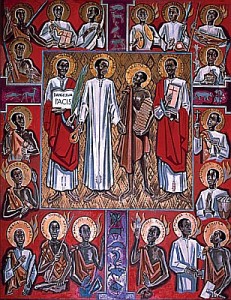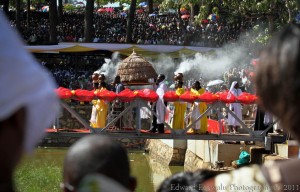“Now if you are unwilling to serve the Lord, choose this day whom you will serve, whether the gods your ancestors served in the region beyond the River or the gods of the Amorites in whose land you are living; but as for me and my household, we will serve the Lord.” [Joshua 24:15]
[L] A portrait of the Ugandan Martyrs. [M] The Basilica of the Ugandan Martyrs built at the spot where St. Charles Lwanga was burnt alive. [R] The massive crowd at the annual Ugandan Martyrs Feast
Our first stop was at the Basilica of the Ugandan Martyrs at Namugongo. In the middle of the huge ground, is the Uganda Martyrs Lake and Pavilion where Mass is celebrated on Martyrs’ Day, June 3. On that day, pilgrims even from neighbouring countries come on foot in massive numbers for their annual pilgrimage.
Of martyrs, someone once wrote: “I believe only those witnesses who have themselves been killed.” Martyrs’ attitude compels respect and their message exudes credibility.
For half of our group, this is a return visit. Our itinerary, however, intentionally took care of the other half of the group who has got to come here, so they too can legitimately tell friends back home that they have indeed been to Uganda. But it is much more than that, of course. Borrowing an image verbalized by Jesuit Daniel Berrigan, a martyr is a saint whose accurate knowledge of Christ passes over instantaneously to love and becomes a single living ferment – a leaven to give life to a people bent low by oppression and despair. A pilgrimage to Uganda would be seriously impoverished without a trip to the Martyrs’ shrine for a hefty reminder of our debt to true witnesses to the faith in Christ.
Three things stood out for us about the Martyrs: their youthful and “lay” status; their staunch counter-cultural witness; and their new life in Christ.
1. “Lay” Faithful as Glorious Martyrs of Faith
The martyrs were all “lay”, not in the banal sense of the term by which Catholics as the “Body of Christ” allow ourselves to be tribally differentiated in a two-tiered church as “the ordained” and “the lay” or the “non-ordained”. For history testifies that such a banal use of the term consciously and unconsciously reduces the People of God to an anti-gospel existence. We see in the Church way too much of a political subjugation of women and the masses for the tribal interests of the ordained-male-governors – a subjugation which is unfortunately hewn in the stone tablets of canon law, and a subject-matter against which Pope Francis has never stopped vehemently railing against in various ways ever since his election to the papacy. Nor is the term intended as in the capricious sense of social stratification and class distinction by which our common identity and equal dignity as the children of God may be insidiously veiled for the sake of privileged and exclusive interests of a few. These Martyrs were lay faithful only in the sense that they did not hold privileged offices in the institutional church. But, with their sacrificial and game-changing testimony, there’s nothing “lay” about their faith and their commitment to faith. Instead, is their faith-witness not every bit as thoroughly professional as you can find in any quarter of the Church, in any part of the world, and in any era of the Church’s history?
- What we admire is their unyielding faith in the God who called them out, summoned them, and assembled them in a group – the qahal Yahweh – so that they could be the authentic People of God – the laos tou Theou, the laikos and the ecclesia.
So there’s no mistaking how completely “professional” these Christian saints were, and how seriously they accepted and lived the Creeds that they professed. In point of fact, martyred in 1886, they produced the spark that ignited the flame of Christianity in modern Africa. And, canonized in 1964, these Martyrs are revered for their faith, their courage, and their counter-cultural witness to Christ. What else could we be looking for in a universal Year of Faith? They gave flesh to the saying that our faith is built on the blood of the martyrs. In the words of Pope John Paul II during his visit to the shrine in 1993, their sacrifice was the seed that “helped to draw Uganda and all of Africa to Christ.”
Stunningly youthful – most were in their teens and twenties – and “lay”, they are truly “founding fathers” of the contemporary church in Africa.
In this painting of twenty-two young men and boys in Ugandan tribal dress, we see the Martyrs standing steadfast in front of a backdrop of upraised spears and flames. The latter remind us of the instruments of torture in Michelangelo’s famous depiction of the Last Judgment carried by angels to the judgment seat of Christ the Supreme Judge.
2. Countercultural Witnesses
Despite their youth, the martyrs of Uganda were not seduced by the values of the royal court where they worked in lowly jobs. So soon after embracing the Christian faith, they could choose not blind obedience to the sick demands of King Mwanga, but obedience to God.
They were found righteous because they broke the law! They took a stand against the law, in disobedience to the king himself who demanded that they recanted from their faith in Christ. But they broke the law in obedience to the will of God – a higher law by far! And they walked the path of disobedience to human law knowing full well that defying the king meant death. But, in dying for their faith, they alert us to such immensely profound lessons of life which, from where we stand, we see the faith community has serious need to grapple with but has hardly begun to do. These lessons are:
- that there is such a reality called the will of God, but that there also is such a reality called the politics of humans;
- that the distinction between the two is seriously blurred, both intentionally and ignorantly;
- that in blatant disobedience to the authority of men, including the ordained authority in the Church, may sometimes be in intense if costly obedience to the will of God; and
- that, more often than not, it takes a bleeding heart of faith to see and then to steadfastly live out this liberating truth.
We call those great Ugandan faithful “Martyrs” because they show us that living a Christian life that is counter-cultural is feasible. We do not have to live like deadwood that drifts with the current. The Martyrs witness to the power of faith to sustain us in times of trial and temptation. Much like the saints in Michelangelo’s The Last Judgment fresco, they have spoken definitively in their historical martyrdom that even in the face of death and torture, one’s faith can persevere and survive. The young Kizito, who was barely 14, brings immense encouragement to Christian families, alerting us to the critical importance of instilling godliness in our children. As we help them learn to honour God and to put God first, we empower them to stand firm against the seductive values of a superficial, hedonistic culture which ultimately leads to spiritual emptiness and meaninglessness in life.
- What we admire is their persistent stand against an immensely powerful figure of authority, the king himself. They remind us of the Biblical teaching: But Peter and the apostles answered, “We must obey God rather than any human authority” [Acts 5:29].
3. New Life in Christ
The young Martyrs understood well what it meant to enter into a new life with Jesus and to follow him. What happened to them? How were they transformed so powerfully? Evidently, once they had received the living Word of God, they accepted it, grafted themselves onto it, like a branch grafting onto the vine [John 15], and it changed their lives and indeed their fate. In that sense they accepted death as the will of God, not in the passive acceptance of violence and murder, which in itself was horrendous, evil and meaningless, but in a meaningful attitude of “positive non-acceptance” as the French philosopher Gabriel Marcel explained it, which is facing the evil in front of them, doing what they must do without waiver, by giving substance to their faith, till death if necessary.
Much like the parable of the sower, the story of the Uganda Martyrs invites us to examine our commitment to the Lord. Here is a group of young people – neophytes in the Christian faith in fact – whose whole life of faith showed nothing but a simple, luminous, joyful trust in God – even in the face of a gruesome death. They were “good soil” indeed [Matthew 13:8] on which the word of God was sown, not just for Africa, but for the whole Church.
- What we admire about the Ugandan Martyrs is the life of holiness they inspire. On this, Cardinal Floni’s homily on the Martyrs of Seoul makes for useful reflection. He said, “Holiness never goes on vacation, and it is neither an accessory to faith nor is it imposed.”
- Pope Francis wrote that there are three fundamental tools for advancing in holiness: Prayer, humility, and charity towards all. At the door of holiness, no one is kept outside, since Christ Himself is the door: “Some of you, perhaps, might say to me: ‘But, Father, I am certainly excluded because I am a great sinner: I have done terrible things, I have done lots of them in my life.” “No,” said the Pope, “you are not excluded! Precisely for this reason you are the favorite, because Jesus prefers sinners, always, in order to forgive them, to love them. Jesus is waiting for you to embrace you, to pardon you. Do not be afraid: he is waiting for you. Take heart, have the courage to enter through his door.”
So as we seriously re-examine our religious beliefs and faith, we ask: What is our faith? What is the basis for our beliefs? Even though we may not want to admit it, there has been a sea change in religious beliefs in the last couple of centuries across the globe and in our personal faith journeys.
- Is our faith the literal acceptance of biblical texts and ecclesiastical dogmas?
- Is our faith a blind obedience to human authorities rather than to God?
- Is what “my feelings tell me” more important than the objective contents of our faith?
- Does our faith yield with total trust and reliance to Jesus’ central message of Kingdom-advancement and embody a total commitment to live a way of life taught by Him?
- Is our faith about the Creator-God and about respecting and upholding the fundamental dignity and equality of every human person?
- Are we unduly focused on the minute details of laws and every provision of the liturgical rules, rather than living the basic commandment of loving God and neighbours?
Lord, teach us persistent faith, courage and authentic living.
Ugandan Martyrs, pray for us. Amen.
Copyright © Dr. Jeffrey & Angie Goh, December 2013. All rights reserved.
You are most welcome to respond to this post. Email your comments to us at jeffangiegoh@gmail.com. You can also be dialogue partners in this Ephphatha Coffee-Corner Ministry by sending us questions for discussion.



